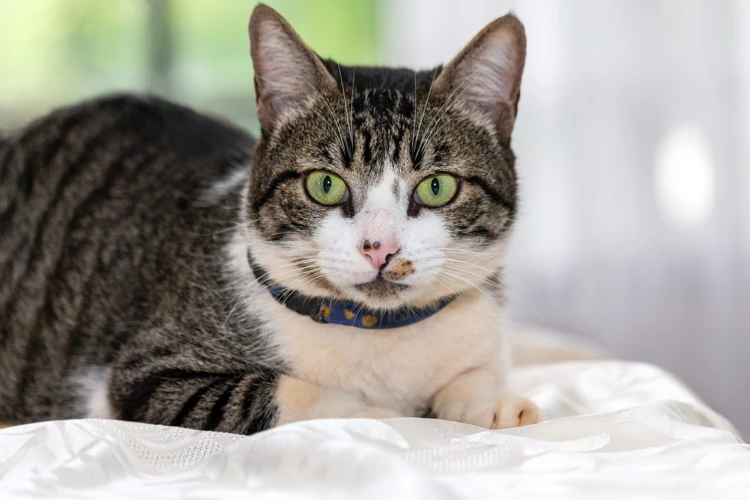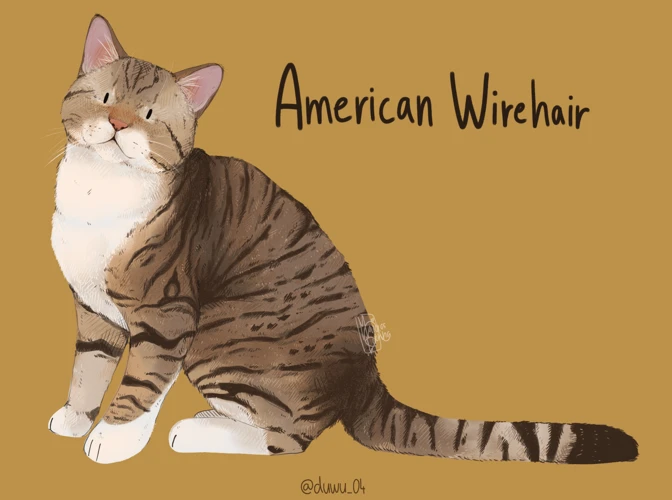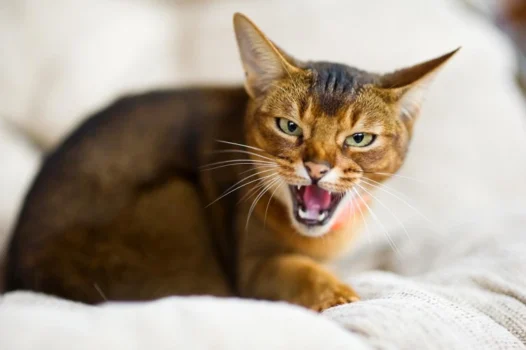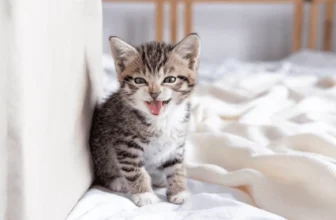As feline owners, we want nothing but the best for our pets, especially when it comes to their behavior. However, when our American Wirehair cats start exhibiting aggressive behavior, it may leave us feeling perplexed and unsure of how to handle the situation. While some aggression is normal, certain types and levels of aggression may require professional help. In this article, we’ll explore the types and common causes of aggression in American Wirehair cats, as well as the signs that indicate your cat may need professional assistance. We will also delve into when it’s time to take your cat to a professional and how to prevent aggression in the first place. Let’s dive in.
Understanding Aggression in American Wirehair Cats

When it comes to American Wirehair Cats, they are well-known for their affectionate and playful nature. However, there might be times when they can display aggression towards their owners, other pets in the household, or even strangers. As a cat owner, it is important to understand the reasons behind this behavior, and how to address it. In this section, we will discuss the various types and common causes of aggression in American Wirehair Cats. This knowledge can help you identify signs of aggression early on, and take appropriate steps to prevent it from escalating. So, let’s dive in and learn more about how to deal with aggression in American Wirehair Cats.
Types of Aggression
Aggression in American Wirehair cats can be of different types and each type has its own characteristics. Here are some of the most common types of aggression seen in American Wirehair cats.
- Territorial Aggression: This type of aggression is shown by cats who are possessive about their territory. When another cat or even a person tries to enter their space, they may become aggressive and attack. You can read more about this type of aggression and how to prevent it here.
- Fear Aggression: When American Wirehair cats feel threatened, they may become aggressive out of fear. This aggression is typically seen when the cat feels they have no escape and needs to defend themselves. You can read more about this type of aggression and how to handle it here.
- Redirected Aggression: This type of aggression occurs when a cat gets aroused by one stimulus and is unable to direct their aggression towards that stimulus, so they redirect it towards something or someone else nearby. This can happen if the cat sees something outdoors and becomes agitated but is unable to physically reach it.
- Play Aggression: Some American Wirehair cats get carried away during playtime and may become aggressive towards their human or feline playmate. This aggression typically includes biting, scratching, and rough play. You can read more about reducing aggression during playtime here.
Identifying the type of aggression that your American Wirehair cat is displaying is important in finding ways to manage it. Understanding the different types of aggression will help you determine the best course of action to take to reduce or eliminate the aggressive behavior.
Common Causes of Aggression
Aggression in American Wirehair cats can stem from various reasons. It is essential to identify the root of aggression to ensure that the correct treatment method is applied. The following are common causes of aggression in American Wirehair cats:
- Poor socialization: American Wirehair cats that were not adequately socialized as kittens can become aggressive towards other cats and humans.
- Territorial aggression: American Wirehair cats can become extremely defensive and territorial over their living space.
- Fear: Fear is another common cause of aggression in American Wirehair cats. Cats that are constantly exposed to stressful situations may start to exhibit signs of aggression because they feel threatened.
- Pain: American Wirehair cats that are experiencing pain or discomfort may become aggressive towards humans or other cats as a way of protecting themselves from further harm.
- Frustration: Cats that feel frustrated due to unfulfilled needs such as hunger, boredom, or the need for mental stimulation, may become aggressive.
Identifying the cause of aggression in American Wirehair cats is the first step towards treating it effectively. For more information on dealing with aggression in American Wirehair cats, check out our article on American Wirehair Cat Aggression. Additionally, techniques for preventing and managing aggression in cats living in multiple cat homes can be found in our article on Preventing Aggression in American Wirehair Cats Living in Multicat Homes, and Training Techniques for Aggressive American Wirehair Cats.
Signs Your American Wirehair Cat Might Need Professional Help

As a cat owner, it can be a challenge to know whether your American Wirehair cat’s aggression is normal or a cause for concern. While some amount of aggression can be expected in cats, aggressive behavior that is persistent or extreme might require professional help. It’s important to pay attention to your cat’s behavior and be aware of any signs that suggest they might need assistance from a veterinarian or animal behaviorist. In this section of the article, we will discuss what to look out for when it comes to your American Wirehair cat’s aggression. Paying attention to these signs will help you determine when it’s time to seek professional help.
Physical Signs
When it comes to detecting potential aggression in American Wirehair cats, there are a few physical signs that you should be aware of. These signs can give you an indication that your cat is feeling aggressive or may become aggressive soon. Here are some physical signs to look out for:
- Dilated pupils: When a cat’s pupils are dilated, it could indicate that they are feeling threatened, scared, or aggressive.
- Flattened ears: If your cat’s ears are pressed firmly against their head, it could be a sign of aggression or fear.
- Arched back: A cat with an arched back may be feeling defensive, threatened, or aggressive.
- Puffed up fur: Puffed up fur is a clear sign that your cat is feeling threatened, scared, or ready to fight.
- Tail position: If your cat’s tail is twitching or lashing back and forth, it could be a sign of aggression or agitation.
It’s important to keep in mind that these physical signs don’t necessarily mean that your cat is aggressive all the time. However, if you notice that your cat is displaying these signs frequently or in certain situations, it may be time to seek professional help to address their aggression. Remember, it’s always better to be safe than sorry when it comes to your cat’s behavior.
Behavioral Signs
Behavioral signs of aggression in American Wirehair Cats are often more subtle than their physical counterparts, and can be more difficult to detect. It’s important to pay close attention to your cat’s behavior in order to recognize these signs early and seek professional help if necessary. Some common behavioral signs to watch out for include:
| Behavioral Signs of Aggression in American Wirehair Cats |
|---|
| Excessive Hissing or Growling – If your cat is hissing or growling more often than usual, this could be a sign of underlying aggression. |
| Stalking or Pouncing – If your cat is regularly stalking or pouncing on people or other animals in your home, this could also be a sign of aggressive behavior. |
| Isolation – If your cat is isolating themselves from you or other pets, this behavior could indicate aggression or fear. |
| Increased Swatting or Scratching – If your cat is swatting or scratching more frequently, especially without provocation, this could also be a sign of underlying aggression. |
| Unusually Defensive Posture – If your cat is exhibiting an unusually defensive posture, with flattened ears and a lowered tail, this could also indicate aggression or fear. |
These behavioral signs can often be a precursor to more physical forms of aggression, such as biting or scratching. If you notice any of these behaviors in your American Wirehair Cat, it’s important to seek professional help as soon as possible to prevent the aggression from worsening.
Internal link: Aggression in American Wirehair Cats
When to Take Your American Wirehair Cat to a Professional

Determining when to seek professional help for your American Wirehair Cat’s aggression can be difficult and overwhelming. It’s natural to feel concerned or unsure about what steps to take next. If you’ve noticed physical or behavioral signs of aggression in your cat, it’s important to assess the situation and consider seeking the guidance of a professional. The safety of your cat and those around them should always be your top priority. In this section, we will discuss the steps you should take when deciding to seek professional help for your American Wirehair Cat’s aggression.
First Steps
If you suspect that your American Wirehair cat needs professional help with their aggression, there are several steps you can take to get started. Here are some important first steps to take:
| Step | Action |
|---|---|
| Step 1 | Observe your cat’s behavior: Take note of when your cat displays aggressive behavior, what triggers it, and how they react. |
| Step 2 | Consult with your veterinarian: Your cat’s aggression could be a sign of an underlying medical issue, so it’s important to rule out any physical causes first. |
| Step 3 | Seek out a qualified behavior professional: Look for a certified animal behaviorist or a qualified cat behavior consultant in your area. They can help diagnose and treat your cat’s aggression, as well as provide guidance on how to prevent future incidents. |
| Step 4 | Keep a log: Keep track of your cat’s progress and any changes in behavior after seeking professional help. This can help you and your behavior professional adjust their treatment plan as necessary. |
Remember, addressing your cat’s aggression is important for their health and well-being, as well as for the safety of those around them. Taking these first steps can help you and your cat on the path towards a happier, healthier relationship.
What to Expect from a Professional
When seeking professional help for aggression in your American Wirehair Cat, it’s important to know what to expect during the process. Here are some things to keep in mind:
- Initial Evaluation: A professional will typically start by performing a thorough evaluation of your cat to determine the cause of the aggression. This may involve a physical exam, bloodwork, and other tests deemed necessary.
- Recommendations: Once the underlying cause of the aggression is identified, the professional will provide recommendations on how to address the issue. This may involve behavior modification techniques, medication, or a combination of both.
- Training and Behavior Modification: Depending on the severity of the aggression, training and behavior modification techniques may be recommended. These can include positive reinforcement training, counter-conditioning, and desensitization techniques. It’s important to work with a professional who has experience working with aggressive cats to ensure the safety of both you and your pet.
- Medication: In some cases, medication may be recommended to treat underlying medical issues or behavioral problems contributing to the aggression. This can include antidepressants or anti-anxiety medications. It’s important to follow the professional’s recommendations for dosage and frequency of medication to ensure its effectiveness.
- Follow-Up Care: Aggression in cats can be a complex issue that requires ongoing care and attention. A professional may recommend follow-up appointments to monitor your cat’s progress and make adjustments to the treatment plan as needed.
It’s important to keep in mind that every cat is unique and may require a different approach when seeking professional help for aggression. Working closely with a professional and following their recommendations can help ensure the safety and well-being of your American Wirehair Cat.
Preventing Aggression in American Wirehair Cats
As a loving pet owner, preventing aggression in your American Wirehair cat is a crucial aspect of maintaining their overall well-being. By incorporating positive reinforcement training and providing a stimulating environment, you can help prevent the development of aggressive tendencies in your feline companion. Additionally, scheduling regular check-ups with your veterinarian can also aid in identifying any potential health issues that may contribute to aggression. Let’s explore these preventative measures in more detail.
Environmental Enrichment
Providing environmental enrichment is an essential way to prevent aggression in American Wirehair cats. By offering them opportunities to play, explore and express their natural instincts, you can help keep your furry friend happy, engaged, and well-behaved.
Here are some ways to provide environmental enrichment for your American Wirehair cat:
- Scratching Posts: American Wirehair cats love to scratch, and providing them with a scratching post can help redirect their natural scratching behavior to a place that won’t damage your furniture. Make sure the post is tall enough for your cat to fully stretch out their body, and sturdy enough to handle their weight.
- Toys: Toys can provide American Wirehair cats with hours of fun and entertainment. Choose toys that simulate natural behaviors, such as hunting, pouncing, and chasing, and rotate them regularly to prevent your cat from becoming bored.
- Cat Trees: Cat trees can provide cats with a high perch to survey their surroundings while providing opportunities to climb, play, and scratch. Choose a tree that fits your cat’s size and personality, and ensure it’s safe and sturdy.
- Hideouts: American Wirehair cats often enjoy having a private place to retreat when they feel stressed. Provide your cat with a cozy hideout, such as a cardboard box or a covered bed, where they can relax and feel safe.
- Window Perches: Giving your American Wirehair cat a window perch can provide them with hours of entertainment as they watch the world go by. Choose a spot that provides a view of birds or other animals and make sure the perch is secure.
By providing environmental enrichment, you can help keep your American Wirehair cat happy, stimulated, and well-behaved. Remember, happy cats are less likely to display aggressive behaviors, so investing time in their well-being is an investment in your cat’s happiness and your own.
Positive Reinforcement Training
Positive reinforcement training is a highly effective way to prevent aggression in American Wirehair cats. This type of training involves using rewards to encourage good behavior, rather than punishment for bad behavior. Here are some examples of positive reinforcement training techniques that can help prevent aggression:
- Clicker training: Clicker training uses a small clicker to signal to your cat that they have done something right, followed immediately by a treat. This technique can be used to teach your cat new behaviors or to reinforce existing ones.
- Treat-based training: Treat-based training involves rewarding your cat with treats when they display good behavior. For example, if your cat tends to be aggressive when you pick them up, you could offer them a treat when they allow you to pick them up without scratching or biting.
- Play-based training: Play-based training involves using playtime as a reward for good behavior. For example, if your cat tends to be aggressive when you try to clip their nails, you could play with them for a few minutes after each successful clipping.
- Target training: Target training involves teaching your cat to touch a specific object, such as a target stick or your hand, with their nose or paw. This can be a useful way to redirect your cat’s aggression towards a specific object instead of towards people or other animals.
It’s important to note that positive reinforcement training requires patience and consistency. You may not see results immediately, but with time and effort, your cat can learn to exhibit more desirable behaviors and become less aggressive.
Regular Check-ups with Your Veterinarian
It’s essential to take your American Wirehair cat to regular check-ups with your veterinarian to prevent aggressive behavior. These visits ensure that your cat is healthy and free from any underlying medical issues that may trigger aggression.
During the check-up, the vet will conduct a thorough physical exam to check for any signs of pain or illness. They will also update your cat’s vaccination schedule and suggest any necessary preventive measures. Additionally, regular check-ups allow your veterinarian to identify emerging behavioral issues promptly.
The Importance of Annual Visit:
Cats should visit their veterinarian at least once a year, but more frequent check-ups are advisable, especially for senior cats or those with pre-existing conditions. As American Wirehair cats age, they can develop problems such as arthritis, dental issues, and other health complications. Regular visits ensure these issues are treated early, preventing pain and discomfort that may contribute to aggressive behavior.
Benefits of a Regular Check-up:
– Early detection and treatment of underlying illnesses
– Access to new veterinary technologies and therapies
– Improved overall health and wellness
– Opportunity for discussion about your cat’s dietary and health needs
– Prevention or management of future aggressive behavior
By taking your American Wirehair cat to a routine check-up, you can establish a long-term relationship with a trusted veterinarian and keep them healthy and happy. Remember, regular check-ups are crucial in preventing and managing aggressive behavior in cats.
Conclusion
In conclusion, it is important to recognize the signs of aggression in your American Wirehair cat. If left untreated, aggression can escalate and become a serious problem. It is crucial to seek professional help when necessary, as there may be medical or behavioral issues contributing to your cat’s behavior.
Remember, prevention is key. Providing your cat with a stimulating environment, positive reinforcement training, and regular check-ups with your veterinarian can all help prevent aggression from developing in the first place.
If you do need to seek professional help, don’t be afraid to reach out to a veterinarian or animal behaviorist. They can provide guidance on how to safely manage and modify your cat’s behavior.
Above all, it is important to approach the situation with patience and understanding. Your American Wirehair cat is a unique individual with their own personality and needs. With the right care and attention, you can help them live a happy and healthy life free from aggression.
Frequently Asked Questions
What is aggression in American Wirehair cats?
Aggression in American Wirehair cats refers to any behavior that is hostile or violent towards humans or other animals.
What are the types of aggression in American Wirehair cats?
Types of aggression in American Wirehair cats include territorial, fear-induced, play, redirected, and intercat aggression.
What are the common causes of aggression in American Wirehair cats?
Common causes of aggression in American Wirehair cats include genetics, lack of socialization, trauma or abuse, and medical issues.
What are the physical signs that an American Wirehair cat may need professional help?
Physical signs that an American Wirehair cat may need professional help include excessive scratching or grooming, dilated pupils, and a stiff or tense body posture.
What are the behavioral signs that an American Wirehair cat may need professional help?
Behavioral signs that an American Wirehair cat may need professional help include increased aggressiveness, becoming withdrawn or fearful, and increased vocalization.
When should I take my American Wirehair cat to a professional?
You should take your American Wirehair cat to a professional if their aggression is becoming more frequent or severe, or if it is impacting their quality of life.
What should I expect from a professional when seeking help for my American Wirehair cat’s aggression?
A professional will likely perform a physical examination and interview you about your cat’s history and behavior. They may also recommend behavior modification therapy or medication.
How can I prevent aggression in my American Wirehair cat?
You can prevent aggression in your American Wirehair cat by providing environmental enrichment, positive reinforcement training, and regular check-ups with your veterinarian.
What is environmental enrichment, and how can it help prevent aggression in my American Wirehair cat?
Environmental enrichment involves providing stimulating objects and activities for your cat, such as toys, scratching posts, and hiding places. This can help reduce boredom and frustration, which can lead to aggression.
What is positive reinforcement training, and how can it help prevent aggression in my American Wirehair cat?
Positive reinforcement training involves rewarding your cat for desirable behaviors, such as using a scratching post instead of your furniture. This can help reinforce good behavior and reduce the likelihood of aggression.






